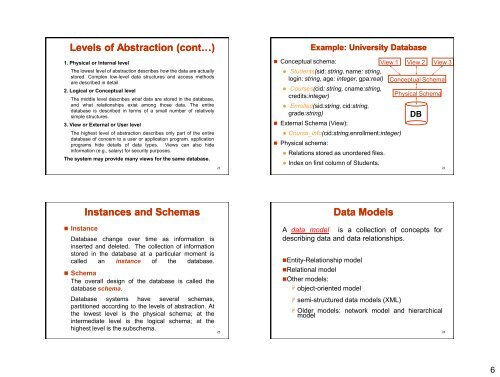Lecture 1: Introduction to Database - Nubacad.com
Lecture 1: Introduction to Database - Nubacad.com
Lecture 1: Introduction to Database - Nubacad.com
Create successful ePaper yourself
Turn your PDF publications into a flip-book with our unique Google optimized e-Paper software.
Levels of Abstraction (cont…)<br />
1. Physical or Internal level<br />
The lowest level of abstraction describes how the data are actually<br />
s<strong>to</strong>red. Complex low-level data structures and access methods<br />
are described in detail.<br />
2. Logical or Conceptual level<br />
The middle level describes what data are s<strong>to</strong>red in the database,<br />
and what relationships exist among those data. The entire<br />
database is described in terms of a small number of relatively<br />
simple structures.<br />
3. View or External or User level<br />
The highest level of abstraction describes only part of the entire<br />
database of concern <strong>to</strong> a user or application program. application<br />
programs hide details of data types. Views can also hide<br />
information (e.g., salary) for security purposes.<br />
The system may provide many views for the same database.<br />
21<br />
• Conceptual schema:<br />
Example: University <strong>Database</strong><br />
• Students(sid: string, name: string,<br />
login: string, age: integer, gpa:real)<br />
• Courses(cid: string, cname:string,<br />
credits:integer)<br />
• Enrolled(sid:string, cid:string,<br />
grade:string)<br />
• External Schema (View):<br />
• Course_info(cid:string,enrollment:integer)<br />
• Physical schema:<br />
• Relations s<strong>to</strong>red as unordered files.<br />
• Index on first column of Students.<br />
View 1 View 2 View 3<br />
Conceptual Schema<br />
Physical Schema<br />
DB<br />
22<br />
• Instance<br />
Instances and Schemas<br />
<strong>Database</strong> change over time as information is<br />
inserted and deleted. The collection of information<br />
s<strong>to</strong>red in the database at a particular moment is<br />
called an instance of the database.<br />
[<br />
• Schema<br />
The overall design of the database is called the<br />
database schema.<br />
<strong>Database</strong> systems have several schemas,<br />
partitioned according <strong>to</strong> the levels of abstraction. At<br />
the lowest level is the physical schema; at the<br />
intermediate level is the logical schema; at the<br />
highest level is the subschema.<br />
23<br />
Data Models<br />
A data model is a collection of concepts for<br />
describing data and data relationships.<br />
•Entity-Relationship model<br />
•[<br />
•Relational model<br />
•Other models:<br />
object-oriented model<br />
semi-structured data models (XML)<br />
Older models: network model and hierarchical<br />
model<br />
24<br />
6







